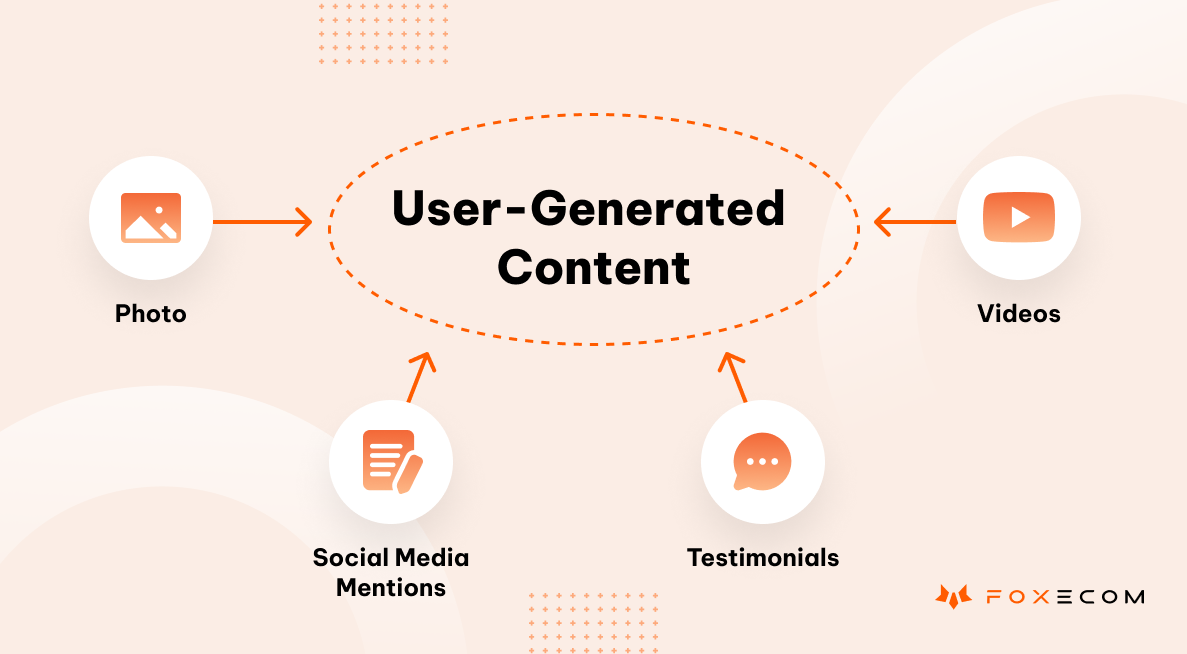In a digital world where authenticity reigns supreme, imagine having an arsenal of content that not only resonates with your audience but also compels them to take action. Enter User-Generated Content (UGC) – the secret sauce that can transform your Shopify store from just another online shop into a thriving community of brand advocates.
In this comprehensive guide, we'll unveil the power of UGC, how it can propel your Shopify store to new heights, and the step-by-step strategies to harness its full potential. Let's embark on a journey to discover the ultimate keys to UGC success!
What is User-Generated Content?
Easy understanding of UGC
User-Generated Content, or UGC for short, is like the digital applause of your audience. It's the content that your customers, followers, or fans create voluntarily, sharing their experiences, opinions, and creativity with the world. In essence, UGC is the real, unfiltered voice of your community
Now, let's translate this concept into the realm of eCommerce UGC here becomes the compelling reviews, stunning images, and heartfelt testimonials that customers produce about your products and brand. They tell the story with their purchases, creating an authentic tapestry of their experiences.
In simple terms, think of it as your customers marketing for you, but in a way that feels genuine and trustworthy.
Types of UGC
UGC comes in various forms, each bringing unique value to your eCommerce table. Here are the three primary types:
- Photos and videos: Customers love to capture the moment when they unbox your product or put it to use. These visuals become powerful UGC, showcasing your product's real-life appeal. If you’re featuring YouTube clips on your site, it’s also smart to add a simple YouTube disclaimer to clarify that the platform and its creators aren’t directly affiliated with your brand. Tools like Usercentrics can also help you manage consent properly when embedding this type of content, ensuring compliance while keeping the user experience seamless.
- Social media mentions: When customers mention your brand or product on social media, it's a spontaneous endorsement. It's the equivalent of word-of-mouth marketing in the digital age.
- Testimonials: Written or video testimonials are like the gold standard of UGC. These endorsements prove that your products or services are worth every penny.

In short, UGC is the chorus of voices that vouch for your brand's excellence, offering a refreshing break from traditional advertising.
How Does User-Generated Content Benefit Your Shopify Store?
Increase brand authenticity
Authenticity is the currency of trust in today's digital marketplace. When potential customers visit your Shopify store and encounter genuine UGC, it instills confidence. They see real people engaging with your products and brand, not paid actors or scripted testimonials.
90% of consumers find authenticity in content to be essential when deciding which brands to support. UGC is the epitome of authenticity, as it reflects the experiences and opinions of your actual customers.

Enhance customer engagement
Customer engagement isn't just a buzzword; it's the lifeblood of your eCommerce success. UGC doesn't just passively sit on your website; it actively engages visitors. When shoppers see UGC like reviews, photos, and videos, they're more likely to stay on your site longer and interact with the content.
According to a report by Yotpo, websites effectively using UGC see a 20% increase in page views and an impressive 90% increase in time spent on the site. This heightened engagement translates into a deeper connection between customers and your brand.

Boost conversion rates
Ultimately, every eCommerce store aims to convert visitors into paying customers. UGC is a conversion powerhouse. When potential buyers see others like them enjoying your products, it eliminates doubts and pushes them closer to the "Buy Now" button.
A study by TurnTo Networks found that 90% of shoppers say UGC influences their purchase decisions more than any other form of advertising. This staggering statistic underscores the pivotal role UGC plays in driving conversion rates.

You’ve known about the User-Generated Content benefit, but the question is how to get and utilize that power; let’s go ahead to the next parts to get answers!
How To Attract User-Generated Content to Your Shopify Store?
Contest
Contests within the eCommerce landscape serve as a dynamic strategy to spur the creation of valuable User-Generated Content (UGC). These contests invite customers and users to participate actively by submitting content related to your products or brand.. The content can range from photos and videos to written reviews and testimonials. Contests are structured with clear objectives, themes, rules, and enticing prizes to motivate participants. They create a powerful engagement loop by encouraging users to interact with your products and share their experiences and creativity.
Pros:
- Engagement boost: Contests create excitement and engagement among your audience, fostering community around your brand.
- Quality UGC: Contests can result in a wealth of high-quality UGC that authentically showcases your products in real-world scenarios.
Cons:
- Resource intensive: organizing and promoting contests can be time-consuming and may require additional resources.
- Winner selection: Choosing winners fairly and transparently can be a delicate process, and public voting can sometimes lead to popularity biases.
Ask broadly on website and social channels
Asking broadly for UGC on your eCommerce website and social media channels involves actively encouraging your customers and followers to share their experiences, photos, videos, and reviews related to your products or brand. This method creates an open and inclusive platform for users to contribute content without specific constraints. By leveraging your website and social media presence, you tap into your audience's engagement, trust, and affinity with your brand, facilitating the creation of authentic UGC.
A great example to illustrate this way here is Glossier. This cosmetic brand usually launches campaigns encouraging social media users to post their images with the hashtag #Glossier. To do that, Glossier provides leading Instagram influencers with pre-release products to educate followers and call for their ideas and thoughts.

Pros:
- Diverse UGC: This method can result in a diverse range of UGC, including photos, videos, and reviews, providing potential customers with a comprehensive view of your products.
- Community building: By encouraging user contributions, you foster a sense of community around your brand, enhancing customer loyalty.
Cons:
- Quality control: When asking broadly, maintaining quality and ensuring that the content aligns with your brand values can be challenging.
Ask directly through messages and email
Asking customers directly for UGC through messages and email is a targeted approach to gathering authentic content. In this method, eCommerce businesses reach out to their customers individually, often after a purchase or interaction, and request them to share their experiences, reviews, photos, or videos related to the products they've bought or their overall brand experience. This personalized outreach encourages participation and strengthens the relationship between the brand and its customers.
Pros:
- Personalized approach: Direct messages and emails allow for a personalized and tailored request for UGC, making customers feel valued and heard.
- Enhanced customer relationship: This method fosters a stronger bond between the brand and its customers, leading to improved loyalty and repeat business.
Cons:
- Privacy concerns: Handling personal data and asking for UGC may raise privacy concerns if not managed appropriately.
Foster a community
Fostering a community involves creating a dedicated space or platform where customers, followers, and enthusiasts of your brand or products can come together, share their experiences, interact with one another, and contribute to UGC. This community-building strategy promotes a sense of belonging and ownership among participants, making them more willing to share authentic content related to your products or brand. The goal is to cultivate a loyal and engaged community that consumes and actively contributes to your brand's story.The goal is to cultivate a loyal and engaged community that consumes and actively contributes to your brand's story.
Pros:
- Engaged and loyal community: Fostering a community creates a dedicated and engaged user base that feels a sense of belonging to your brand, leading to enhanced customer loyalty.
- Continuous UGC: A vibrant community continually generates UGC, providing a consistent source of authentic content for your brand.
Cons:
- Content quality control: Maintaining control over the quality and relevance of UGC within a community can be challenging.
How To Leverage User-Generated Content on Your Shopify Store?
Once you've collected a valuable reservoir of UGC, the next step is to make the most of it. Here's how to effectively leverage UGC to enhance your Shopify store:

Step 1: Sort and Filter
Sorting and filtering UGC is pivotal in managing the content you gather from your customers and community. It involves a systematic process of evaluating and curating UGC to ensure that the content aligns with your brand's values, resonates with your target audience, and positively represents your products or services.
How to do it effectively:
- Establish clear criteria: Begin by defining specific criteria for evaluating UGC. Your criteria should encompass factors such as relevance, quality, authenticity, alignment with brand values, and the intended use of the content. For instance, consider whether the UGC showcases your products in diverse settings or highlights unique user experiences.
- Segmentation and tagging: Organize UGC into categories based on product type, customer demographics, content format (e.g., photos, videos, reviews), and campaign focus. Use tagging or labeling systems to facilitate easy retrieval and sorting.
- Content moderation: Implement a robust content moderation system to filter out content that doesn't align with your brand's image or could potentially be offensive. This helps maintain a positive and safe environment for your audience.
- Regular auditing: Conduct regular audits of your UGC collection to ensure the content you showcase remains up-to-date and relevant. Refresh and update content as needed to keep it engaging and reflect current trends.
Professional tips:
Always keep the trend in mind. Stay informed about current trends and cultural shifts that may impact the relevance and acceptability of UGC. Adaptability and responsiveness to emerging trends can keep your content fresh and engaging.
Step 2: Make a plan for distribution
Crafting an effective UGC distribution plan involves meticulous planning to determine when, where, and how to publish this valuable content. The goal is to strategically showcasing UGC across various digital platforms and channels to engage your audience, foster trust, and meet your marketing objectives.
How to do it effectively:
- Content calendar: Begin by creating a content calendar that outlines the publication schedule for your UGC. Align this calendar with your broader marketing initiatives, product launches, or seasonal promotions. Ensure a consistent flow of UGC content throughout the year.
- Platform alignment: Tailor UGC content to match the unique characteristics of each platform where you intend to share it. Adapt the content format, tone, and style to cater to the preferences and behaviors of users on different platforms, including social media, your website, email, and other channels.
- Performance tracking: Implement robust analytics to monitor UGC performance across different channels. Assess engagement metrics, conversion rates, and user behavior to fine-tune your distribution strategy over time.
- User engagement: Actively engage with users whose content you feature. Acknowledge their contributions, respond to comments, and encourage them to share featured content within their networks.
- Consistency: Maintain a consistent posting schedule across platforms to engage your audience and build anticipation.
Professional tips:
Variety is Key. Keeping your UGC distribution plan diverse by mixing content formats (e.g., photos, videos, reviews) and platforms. This prevents monotony and appeals to a wider audience.
A good plan must go along with good management. To execute your plan on distributing UGC, you must manage your UGC materials well, which is a heavy-loading task in almost any case. However, a simple solution is to consider using User-Generated Content platforms such as GRIN, Creator.co, Upfluence, etc.
Step 3: Showcase on the online store
Showcasing User-Generated Content (UGC) on your online store is vital because it builds trust, authenticity, and engagement. UGC serves as real, unfiltered endorsements from satisfied customers, fostering credibility and differentiation. It not only boosts conversions but also creates an interactive shopping experience.
How to do it effectively:
- UGC widgets: Utilize UGC widgets or plugins that seamlessly integrate UGC into various parts of your online store. These widgets can be embedded in product, category, and checkout pages.
- Product pages: Incorporate UGC directly into individual product pages. Alongside product descriptions, feature user-generated reviews, photos, or videos that provide real-life perspectives on your products.
- Highlight user experiences: Use UGC to tell the stories of your customers. Showcase their journeys, experiences, and transformations with your products. Include captions or descriptions that provide context and inspire others.
Professional tips:
Again, variety is a key here. You need diverse sections that are nice-looking to showcase UGC and attract shoppers’ attention. To do that effortlessly, you can use Shopify themes like Minimog. It comes with built-in features and sections to simplify the showcasing of UGC, such as Testimonials, Instagram, Press, Slideshow, etc. You can ensure UGC integration aligns seamlessly with your store's design and functionality by leveraging them.
Step 4: Deliver through multiple channels
More than just showcasing, UGC in Shopify stores is required. In today's digital world, you can do more than that. Delivering UGC through multiple channels is a strategic approach to maximize its impact and reach a broader audience. Effectively utilizing various channels like your online store, social media, email marketing, blog, and more can significantly enhance the visibility and credibility of your UGC.
How to do it effectively:
- Blog: Create blog posts around customer success stories, product reviews, or how-to guides incorporating UGC. This not only adds value to your blog content but also showcases the authenticity of your brand.
- Social media: Leverage popular social media platforms to amplify the reach of UGC. Share user-generated content on channels where your target audience is most active. Encourage users to engage with and share this content to broaden its exposure.
- Email marketing: Incorporate UGC into your email marketing campaigns. Feature customer reviews, success stories, or UGC highlights in your email newsletters to provide social proof and inspire trust among your subscribers.
Professional tips:
Platform-specific content. Since each channel will have different algorithms and audience behaviors, you must tailor your UGC for each platform to maximize the results. For example, you can write a lengthy article to showcase detailed customer experience. Still, you need to shorten or repurpose it into video format to put on Instagram and TikTok because social media users prefer short-form content.
Wrapping up
In the ever-evolving world of eCommerce, trust, authenticity, and engagement are the pillars upon which successful brands are built. In this ultimate guide, we’ve explored the essence of User-Generated Content (UGC) and learnt how to attract and leverage them to boost your brand credibility and business performance.
To make the most of UGC, a valuable tip is to use Shopify themes like Minimog to showcase them . Minimog helps you in not only designing a visual-stunning online store to capture shoppers’ attention but also diverse sections to showcase your UGC effortlessly.
So now, it's time to discover the power of Minimog and unlock the potential of UGC, and watch your Shopify store thrive like never before.






